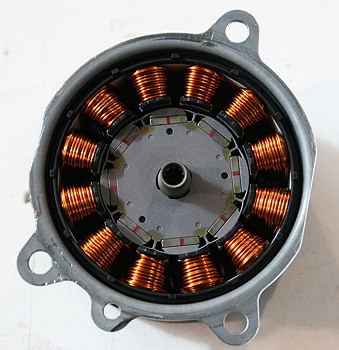- Home » News » Technology News
Researchers say they can cut rare-earth use in motors by 80%

German researchers say that they have found ways of reducing the amount of critical rare-earth materials needed to build electric motors by up to 80%. In a five-year project that has just ended, the researchers from eight Fraunhofer Institutes pooled their expertise to find ways of reducing the need for rare-earth materials by a combination of optimising manufacturing processes, developing new approaches to recycling, and looking for new materials that could replace rare-earths.
The project was triggered by the rare-earth crisis that started about a decade ago when China, which dominates the global production of these critical materials, cut off supplies to Japan, and limited exports to other countries, causing the cost of the materials to skyrocket. Rare earths – which include neodymium, dysprosium and yttrium – are used in a wide range of applications, from electric vehicles and wind turbines, to computer hard drives and mobile phones.
The crisis revealed the vulnerability of German industry to any disruption in the supply of these materials.
The Fraunhofer project, called Criticality of Rare Earths, set out to find ways of using rare earths more wisely and to find substitute materials, especially for dysprosium and neodymium which are used in high-power magnets for electric motors.
Finding ways of cutting the use of rare earths is particularly important for the automotive sector because modern vehicles contain dozens of motors, many of them relying on permanent magnets containing rare earths. With the trend towards electrically powered and hybrid transport, the demand for powerful permanent magnet motors is growing.
The Fraunhofer team based their work on two benchmark examples of motors, one of them used widely in gearboxes. “Our goal was to halve the need for rare earths in these benchmark motors,” says project spokesman Prof Ralf Wehrspohn, who heads the Fraunhofer Institute for Microstructure of Materials and Systems.
The researchers analysed the global markets for rare earths, and developed concepts for reusing or recycling of rare earths when designing motors. They also targeted magnet manufacturing processes to find ways of cutting waste. For example, they showed that injection moulding can be used to form magnetic materials into desired shapes, together with a plastic binder, and then sintered. This approach also eliminates the time and cost of having to rework magnets.
In another sub-project, the researchers developed a method for recycling permanent magnets from sources such as electronic devices, wind turbines and cars. The magnets are treated with hydrogen which causes them to disintegrate. The resulting particles are then re-poured or sintered to produce recycled magnets that can achieve 96% of the capacity of new magnets.

They also developed a “unique” method for introducing dysprosium into grain boundary phases by a combination of spark plasma sintering and hot pressing, resulting in anisotropic magnets that are suitable for a wide range of motor applications.
The design of the benchmark electric motors has also been optimised. By preventing the motors from becoming too hot during operation, the researchers found that magnets with a lower temperature stability, and thus a lower proportion of dysprosium, can be used.
The team also discovered alternative materials that can act as powerful magnets, but do not contain rare earths. They tested numerous combinations of materials and demonstrated substitute alloys that contain, among other things, cerium, and have a good magnetic performance. The substitute materials were also analysed for their current and expected security of supply.
The German researchers estimate that, by combining all of the techniques that they developed during the project, the amount of dysprosium and neodymium needed for electric motors could be reduced to around 20% of previous levels.
“We tackled the topic from the quantum physical computer simulation of magnetic materials, to near-net-shape magnet production, to the recovery and recycling of rare-earth metals at the end of a product’s life cycle,” Wehrspohn reports. “Thanks to the breadth and depth of competences, which are also unique on an international scale, we have made very concrete progress and identified further starting points for the more efficient use and substitution of rare earths. We now want to bring these results to the market with partners from industry.”





